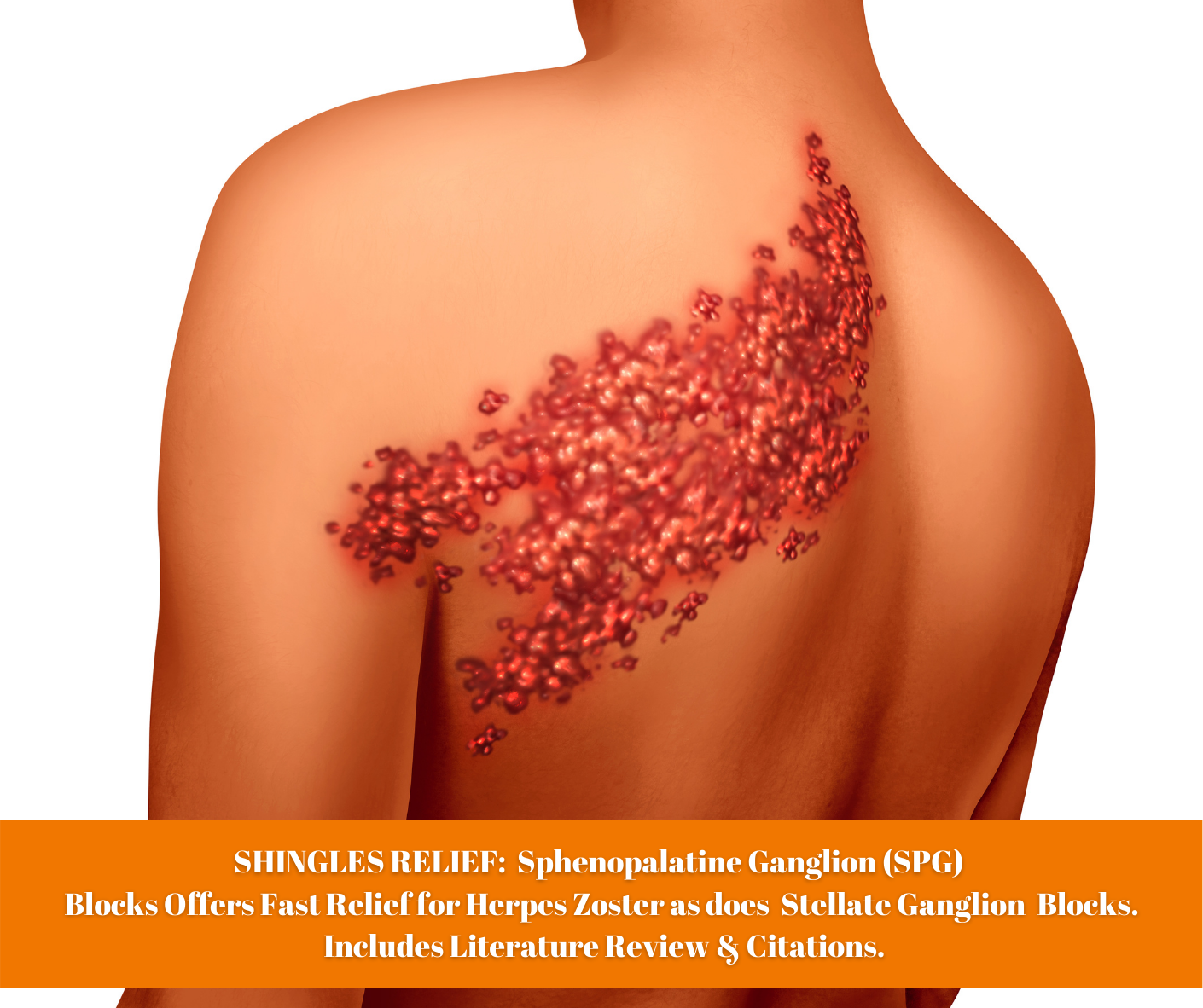 Autonomic Blocks: Sphenopalatyine Ganglion Blocks and Stellate Ganglion Blocks can give amazing relief from the pain of a Herpes Zoster Episode. These episodes may occur decades after the original varicella-zoster virus which caused Chicken Pox is reactivated.
Autonomic Blocks: Sphenopalatyine Ganglion Blocks and Stellate Ganglion Blocks can give amazing relief from the pain of a Herpes Zoster Episode. These episodes may occur decades after the original varicella-zoster virus which caused Chicken Pox is reactivated.
SASPGB: Self-Administered SPG Blocks offer exceptional patient controlled pain relief especially for Trigeminal Nerve Pain of Herpes Zoster including Eye Pain!
This may safely be considered as a First Line Treatment for alleviating pain of Shingles especially affecting the head and neck.
Sphenopalatine Ganglion Blocks have been utilized to treat pain since 1908 when it was first described by Dr Greenfield Sluder to treat Sluders Neuralgia. His textbook “NASAL NEUROLOGY: HEADACHES AND EYE DISORDERS ” was the state of the art for many years. Dr Sluder was Chair of Otolaryngology at Washington University School of Medicine is St Louis. He purposely titeld the book “Nasal Neurology” due to importance of Sphenopalatine Ganglion Blochs in all cases of head, neck and eye pain due to tyhe Sympathetic and Parasympathetic nerves that travel with the Trigeminal Nerve.
On page 104 of Sluder’s book is a case observed by W. M. C. Bryan where anesthetic (cocaine) to the Sphenopalatine Ganglion stopped intense Herpes pain in the Eyeball and in the maxillary division of the Trigeminal nerve. His text has 80 pages of case histories treated by Ganglion Blocks including Acute Blindness, Vacumn Frontal Headaches, Anterior Ethmoidal Neuralgia, Asthma, and Vidian Neuralgia to mention just a few.
Shingles is a result of reactivation of the Herpes Zoster viral infection of the varicella-zoster virus. It is usually extremely painful and pain is the first presenting symptom. Shingles is usually self-limited to follow nerve pathways or dermatomes, often causing a dermatomal rash.
Symptoms typically begin with pain along the affected dermatome by and are then followed by a vesicular eruption 3-5 days later. According to Mayo Clinic the Symptoms include:
“The signs and symptoms of shingles usually affect only a small section of one side of your body. These signs and symptoms may include:
- Pain, burning, numbness or tingling
- Sensitivity to touch
- A red rash that begins a few days after the pain
- Fluid-filled blisters that break open and crust over
- Itching
Some people also experience:
- Fever
- Headache
- Sensitivity to light
- Fatigue”
There are numerous studies on the use of Autonomic Blocks for treating Shingles, recurrent Herpes Zoster outbreaks. Combined stellate ganglion and sphenopalatine ganglion block in acute herpes infection. https://pubmed.ncbi.nlm.nih.gov/8358137/
Abstract
The Sphenopalatine Ganglion (SPG) is known to play an integral role in the pathophysiology of a wide variety of orofacial pains involving the jaws, sinuses, eyes and the trigeminal autonomic cephalalgias. It supplies direct parasympathetic innervation to the trigeminal and facial nerves. Sympathetic innervation from the superior sympathetic chain passes thru the SPG to the trigeminal and facial nerves.This paper reviews relevant and significant literature on SPG Blocks and Neuromodulation published in peer reviewed medical and dental journals. Neuromuscular Dentistry employs ULF-TENS to relax musculature and simultaneously provide neuromodulation to the ganglion.Conclusion: The effects of ULF-TENS on the autonomic nervous system acts on the Limbic System and Hypothalamus (H-P-A) to address Axis II issues during neuromuscular dental procedures. It also directly affects the autonomic component of the trigeminal nerve involved in almost all headaches and migraines as well as the Myofascial and Joint disorders of TMD.
Keywords: Neuromuscular Dentistry; Sphenopalatine Ganglion (SPG) Block; Sphenopalatine Ganglion (SPG) Neuromodulation; Trigeminal Autonomic Nervous system; ULF-TENS.
Stellate block for trigeminal herpes zoster
Combined stellate ganglion and sphenopalatine ganglion block in acute herpes infection
Abstract: Herpes zoster is characterized by unilateral vesicular eruption and it most often affects the trigeminal nerve. We would like to report a rare case of abducens and vagus nerves palsy caused by varicella zoster virus (VZV) without the typical vesicular rash.

 1
1
Permalink
Got rid of Hsv,,Worked for me,,,,,,,,,,,,,